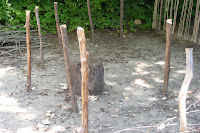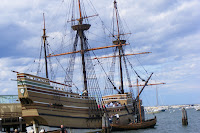



Canoes were very important to the Wampanoag people. They used them to travel and to fish. The Wampanoag made canoes by using huge tree trunks. They would set the top part of the trunk on fire and scrape away the ashes until the trunk was dug deep enough so that they could sit in it. Canoes were made in different sizes. They could carry one or two people or an extremely large one might hold as many as 30 paddlers.
Equally important were the lobster traps that the Wampanoag fashioned. They placed sticks in the water in the shape of a semi-circle. Then they wove twigs around the poles. That way when the lobster or any fish would gather in this area, the Wampanoag could throw their nets over the open side to trap the fish or lobster.





























